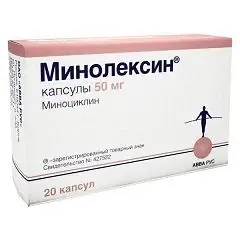- Author Rachel Wainwright [email protected].
- Public 2023-12-15 07:39.
- Last modified 2025-11-02 20:14.
Minoleksin
Minoleksin: instructions for use and reviews
- 1. Release form and composition
- 2. Pharmacological properties
- 3. Indications for use
- 4. Contraindications
- 5. Method of application and dosage
- 6. Side effects
- 7. Overdose
- 8. Special instructions
- 9. Application during pregnancy and lactation
- 10. Use in childhood
- 11. In case of impaired renal function
- 12. For violations of liver function
- 13. Drug interactions
- 14. Analogs
- 15. Terms and conditions of storage
- 16. Terms of dispensing from pharmacies
- 17. Reviews
- 18. Price in pharmacies
Latin name: Minolexin
ATX code: J01AA08
Active ingredient: minocycline (minocycline)
Manufacturer: AVVA RUS, JSC (Russia)
Description and photo updated: 22.11.2018
Prices in pharmacies: from 539 rubles.
Buy

Minolexin is an antibiotic of the tetracyclines group.
Release form and composition
Dosage form Minoleksin - capsules: gelatinous solid, size No. 2, with a body and a yellow cap for a dosage of 50 mg and white for a dosage of 100 mg; the capsules contain yellow powder (in a cardboard box 2 or 3 blisters of 10 capsules).
Composition of 1 capsule:
- active substance: minocycline hydrochloride - 50 or 100 mg;
- auxiliary components (50/100 mg): microcrystalline cellulose - 73.5 / 147 mg; low molecular weight povidone - 8.75 / 17.5 mg; potato starch - 7/14 mg; magnesium stearate - 1.75 / 3.5 mg; lactose monohydrate - up to 175/350 mg;
- capsule (50 mg): titanium dioxide - 0.974-2%; water - 13-16%; quinoline yellow dye - 0.583 3-0.75%; sunset yellow dye (E110) - 0.002 5-0.005 9%; gelatin - up to 100%;
- capsule (100 mg): titanium dioxide - 2-2,111 8%; water - 13-16%; gelatin - up to 100%.
Pharmacological properties
Pharmacodynamics
Minolexin is one of the semi-synthetic antibiotics from the tetracyclines group. Due to the reversible inhibition of protein synthesis at the level of 30S ribosome subunits, it has a bacteriostatic effect on the cells of microorganism strains exhibiting sensitivity. Has a wide range of antibacterial activity.
The following microorganisms are sensitive to the action of minocycline hydrochloride:
- aerobic gram-positive: Listeria monocytogenes, Bacillus anthracis, Streptococcus pneumoniae, Staphylococcus aureus. Some of them are resistant to minocycline, therefore, laboratory sensitivity tests are recommended before using the drug. If the sensitivity of microorganisms to minocycline has not been identified, therapy with antibiotics of the tetracyclines group for streptococcal and staphylococcal infections is not recommended;
- aerobic gram-negative: Calymmatobacterium granulomatis, Campylobacter fetus, Haemophilus ducreyi, Francisella tularensis, Brucella species, Bartonella bacilliformis, Yersinia pestis, Vibrio cholera.
For the following microorganisms, preliminary testing of sensitivity to minocycline is strongly recommended: Shigella species, Enterobacter aerogenes, Klebsiella species, Neisseria gonorrhoeae, Neisseria meningitidis, Acinetobacter species, Haemophilus influenzae, Escherichia coli.
Additionally: Fusobacterium nucleatum subspecies fusiforme, Mycoplasma pneumoniae, Mycobacterium marinum, Rickettsia, Treponema pallidum subspecies pallidum, Ureaplasma urealyticum, Borrelia recurrentis, Actinomyces species, Treponema pallidum subspecies pertenitue psi, Treponema pallidum subspecies pertenitue pspecies
Pharmacokinetics
Food intake has no significant effect on the absorption of minocycline. The degree of solubility of the substance in lipids is high, the affinity for binding Ca 2+ is low. It is absorbed from the digestive tract quickly in proportion to the dose taken. C max (maximum concentration of a substance) in blood plasma after oral administration at a dose of 200 mg is 3.5 mg / l, the time to reach it is from 2 to 4 hours.
The degree of binding to blood proteins is 75%; the influence of various diseases on this parameter has not been studied. V d (volume of distribution) - 0.7 l / kg. It penetrates well into tissues and organs - within 30-45 minutes after ingestion in therapeutic concentrations, it is found in the spleen, kidneys, eye tissues, ascitic and pleural fluids, gingival fluids, frontal / maxillary sinus exudate, synovial exudate. It penetrates well into the cerebrospinal fluid (concentration is 20-25% of plasma). Minocycline crosses the placental barrier and is excreted in breast milk.
May cumulate with repeated use. It accumulates in bone tissue and the reticuloendothelial system. The formation of insoluble complexes with Ca 2+ takes place in teeth and bones.
Minocycline undergoes enterohepatic recirculation. Excretion occurs within 72 hours: with intestinal contents - from 30 to 60% of the dose taken; kidneys - 30% (of which unchanged - 20-30%); with chronic renal failure in severe course - only from 1 to 5%. T 1/2 (half-life) of minocycline is about 16 hours.
Indications for use
According to the instructions, Minoleksin is prescribed for the treatment of the following diseases (in case of sensitivity of pathogenic microorganisms):
- acne;
- skin infections;
- typhoid fever, spotted / typhoid fever, coxiellosis (Q fever), tick fever and vesicular rickettsiosis;
- lymphogranuloma venereum;
- respiratory tract infections;
- psittacosis;
- paratrachoma (conjunctivitis with inclusions);
- trachoma (infectious keratoconjunctivitis);
- non-gonococcal urethritis, infections of the cervical canal and anus in adults;
- tularemia;
- gonorrhea, syphilis, chancroid;
- cyclical fever;
- plague;
- brucellosis;
- cholera;
- inguinal granuloma;
- bartonellosis;
- actinomycosis;
- yaws (non-venereal syphilis, tropical granuloma);
- listeriosis;
- ulcerative filmy sore throat of Simanovsky - Plaut - Vincent;
- anthrax.
The use of Minolexin is indicated in patients with asymptomatic carriage of Neisseria meningitidis for the purpose of eradication of meningococci from the nasopharynx.
In acute intestinal amebiasis, it is permissible to prescribe minocycline as an adjunct to amoebicidal drugs.
In cases of severe acne, Minolexin can be used as an adjuvant therapy.
In order to prevent the development of resistance, the use of the drug is recommended in accordance with the results of laboratory tests, including serotyping and determining the sensitivity of the pathogen. For the same reason, in the case of a high risk of meningococcal meningitis, the use of minocycline for prevention is not recommended.
The experience of the clinical use of Minolexin has shown its effectiveness in the treatment of Mycobacterium marinum infections, but at present this information has not been confirmed by the results of controlled clinical trials.
Contraindications
Absolute:
- severe hepatic / renal impairment;
- porphyria;
- systemic lupus erythematosus;
- leukopenia;
- lactose intolerance, lactase deficiency, glucose-galactose malabsorption;
- combined use with isotretinoin;
- pregnancy and the period of breastfeeding;
- age up to 8 years (period of tooth development);
- individual intolerance to the components of the drug and other tetracyclines.
Relative (Minoleksin is prescribed under medical supervision):
- impaired renal / hepatic function;
- combined use with hepatotoxic drugs.
Instructions for the use of Minoleksin: method and dosage
Minolexin is taken orally, preferably after meals. In order to reduce the likelihood of ulceration and irritation of the esophagus, it is recommended to drink the capsules with a sufficient amount of liquid (milk can be used).
If the drug is to be used 2 times a day, the interval between single doses is 12 hours.
The initial dose is 200 mg, then Minolexin is taken 2 times a day, 100 mg. The maximum is 400 mg per day.
Recommended scheme of application depending on indications:
- acute inflammatory diseases of the pelvic organs in women: 2 times a day, 100 mg, in some cases in combination with cephalosporins;
- infections of the anogenital region and genitourinary system caused by ureaplasma / chlamydia: 2 times a day, 100 mg for a course of 7 to 10 days;
- gonorrhea: 2 times a day, 100 mg in a course of 4 to 5 days, or once in a dose of 300 mg;
- primary syphilis with hypersensitivity to penicillins: 2 times a day, 100 mg for a course of 10 to 15 days;
- uncomplicated gonococcal urethritis in men: 2 times a day 100 mg for 5 days;
- uncomplicated gonococcal infections in men (except for urethritis and anorectal infections): the initial dose is 200 mg, the maintenance dose is 100 mg 2 times a day for a course of at least 4 days, 2-3 days after stopping Minolexin, a microbiological assessment of recovery is performed;
- acne: once a day, 50 mg for a course of 6 to 12 weeks.
During therapy, it is possible to increase the plasma level of urea in the blood. In the absence of impaired renal function, this violation does not require Minolexin to be canceled. With severe renal impairment, azotemia, hyperphosphatemia, and acidosis may occur. In such cases, control of the level of urea and creatinine in the blood plasma is required, the daily dose should not exceed 200 mg.
Children from 8 years old with infections caused by pathogens sensitive to minocycline, Minolexin is prescribed in the following doses: initial - 4 mg / kg, then 2 times a day at 2 mg / kg.
The initial dose for children with a body weight of 25 kg or more is 100 mg, the maintenance dose is 50 mg 2 times a day.
Side effects
Adverse reactions associated with taking Minolexin do not differ from the profile of other tetracyclines.
Possible violations:
- genitourinary system: balanitis, interstitial nephritis, vulvovaginal candidiasis, dose-dependent increase in plasma urea;
- musculoskeletal system: myalgia, arthritis, arthralgia, discoloration of bone tissue, limitation of mobility and joint swelling;
- central nervous system: dizziness, convulsions, headaches, numbness (including limbs), lethargy, increased intracranial pressure in adults, vertigo;
- digestive system: cholestasis, hyperbilirubinemia, increased activity of hepatic enzymes, stomatitis, anorexia, dysphagia, pseudomembranous colitis, enterocolitis, nausea, diarrhea, dyspepsia, vomiting, glossitis, hepatitis (including autoimmune), hypoplasia, dental erythematosus lesions (including fungal) in the anogenital area / oral cavity, liver failure (including terminal);
- respiratory system: pneumonia, bronchospasm, shortness of breath, exacerbation of asthma;
- hematopoietic system: pancytopenia, neutrocytopenia, eosinophilia, eosinopenia, hemolytic anemia, agranulocytosis, thrombocytopenia, leukopenia;
- skin: itching, erythema nodosum, baldness, erythematous and maculopapular rash, exfoliative dermatitis, Stevens-Johnson syndrome, nail pigmentation, toxic epidermal necrolysis (Lyell's syndrome), vasculitis;
- metabolism: dysfunction of the thyroid gland, malignant neoplasm of the thyroid gland (single case);
- sense organs: hearing impairment and tinnitus;
- allergic reactions: urticaria, polyarthralgia, angioedema, anaphylactic reactions (including shock), anaphylactoid purpura (Schönlein-Henoch purpura), exacerbations of systemic lupus, pericarditis, lung infiltration, proceeding with eosinophilia;
- others: fever, discoloration of the oral cavity (gums, tongue, palate) and tooth enamel, staining of secretions (in particular, sweat).
Overdose
Main symptoms: vomiting, nausea, dizziness.
Therapy: Minolexin is canceled, symptomatic and supportive treatment is indicated. Hemo- and peritoneal dialysis removes a small amount of minocycline. The antidote is unknown.
special instructions
During a long treatment course, it is necessary to carry out functional liver tests and regular monitoring of the cellular composition of peripheral blood, as well as determine the concentration of urea and nitrogen in the serum.
A false increase in the level of catecholamines in urine is possible if they are determined by the fluorescent method.
Women using contraceptives with estrogens should use additional contraceptives or a combination of them during Minolexin therapy.
When conducting a study of a biopsy of the thyroid gland in patients who have been receiving tetracyclines for a long time, it is necessary to take into account the possibility of dark brown staining of tissue in micropreparations.
During treatment and 2-3 weeks after its completion, diarrhea caused by Clostridium difficile (pseudomembranous colitis) may occur. In mild cases, it is enough to cancel the treatment followed by the use of ion exchange resins (colestyramine, colestipol). In severe cases, the following measures are necessary: replacement of fluid, protein and electrolyte losses, therapy with vancomycin, bacitracin or metronidazole. Drugs that slow down intestinal motility cannot be used.
To avoid the appearance of resistance, it is necessary to carry out therapy with Minolexin only in accordance with the results of a study of the sensitivity of pathogenic microorganisms. If it is impossible to conduct a study, the epidemiology and sensitivity profile of microorganisms existing in a particular region should be taken into account.
Patients with sexually transmitted diseases with suspected concomitant syphilis should be examined by dark field microscopy before taking Minolexin. The recommended frequency of serological diagnostics of blood serum is at least 1 time in 4 months.
Periodic laboratory diagnosis of body functions is required, including liver and renal / hematopoietic functions.
If some adverse reactions occur, the following measures are shown:
- superinfection: Minolexin is canceled, adequate treatment is carried out;
- increased intracranial pressure: Minolexin is canceled;
- diarrhea: you should urgently consult a doctor;
- erythema: Minolexin is canceled (associated with an increase in sensitivity to direct sunlight and ultraviolet radiation).
Influence on the ability to drive vehicles and complex mechanisms
Patients during therapy with Minolexin should be careful when driving, which is associated with the likelihood of dizziness.
Application during pregnancy and lactation
- pregnancy: Minolexin can be used only in cases where the expected benefit is higher than the possible risk;
- lactation period: therapy is contraindicated.
Pediatric use
Minolexin therapy is contraindicated in patients under 8 years of age (the period of dental development).
With impaired renal function
- severe renal failure: therapy is contraindicated;
- impairment of renal function: Minolexin should be used under medical supervision.
For violations of liver function
- severe hepatic impairment: therapy is contraindicated;
- hepatic dysfunction: Minolexin should be used under medical supervision.
Drug interactions
- penicillins: combinations should be avoided;
- anticoagulants: a decrease in the prothrombin activity of blood plasma, which may require a decrease in the dose of anticoagulants;
- isotretinoin (before / simultaneously / immediately after taking Minolexin): the likelihood of a benign increase in intracranial pressure increases, so this combination is recommended to be avoided;
- antacids containing aluminum, calcium, magnesium, iron-containing drugs: the absorption of Minolexin is impaired, which may cause a decrease in its effectiveness;
- oral contraceptives: decreased effectiveness of contraception;
- methoxyflurane: possible development of end-stage renal toxicity;
- ergot alkaloids and their derivatives: the likelihood of ergotism increases.
Analogs
Minolexin's analogs are Bassado, Vibramycin, Vidoccin, Dovitsin, Doksal, Doxibene, Tetracycline, Tigacil, Xedocin, Monoclin and others.
Terms and conditions of storage
Store in a place protected from light and moisture at temperatures up to 25 ° C. Keep out of the reach of children.
Shelf life is 2 years.
Terms of dispensing from pharmacies
Dispensed by prescription.
Reviews about Minoleksin
Reviews about Minoleksin mainly relate to the use of acne. In most cases, its high efficiency is noted. Of the shortcomings, they point to the need for a long course, the likelihood of side effects (requiring discontinuation of therapy) and the short duration of the effect.
The price of Minoleksin in pharmacies
The approximate price for Minolexin for 20 capsules per package is: dosage 50 mg - 524-699 rubles; dosage of 100 mg - 875-1050 rubles.
Minoleksin: prices in online pharmacies
|
Drug name Price Pharmacy |
|
Minolexin 50 mg capsules 20 pcs. RUB 539 Buy |
|
Minolexin 100 mg capsules 20 pcs. 750 RUB Buy |
|
Minolexin capsules 100mg 20 pcs. 999 RUB Buy |

Maria Kulkes Medical journalist About the author
Education: First Moscow State Medical University named after I. M. Sechenov, specialty "General Medicine".
Information about the drug is generalized, provided for informational purposes only and does not replace the official instructions. Self-medication is hazardous to health!






